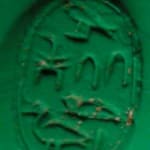Egyptian Scarab, 1991 BCE - 1783 BCE
0.825
LO.1122
The entomological details of the top of this scarab are carefully designed and include the head and its component elements, namely, the plate, eyes, and clypeus, all of which are...
The entomological details of the top of this scarab are carefully designed and include the head and its component elements, namely, the plate, eyes, and clypeus, all of which are clearly articulated. The thorax is divided from the elytra, itself divided into two parts, by deeply scored lines, and the legs are likewise well-defined.
The bottom of our scarab is inscribed with a title and name of its owner, “The Great One of Nubia (?), [named] Sa-sobek.” The orthography of the individual hieroglyphs and their arrangement in the field find their exact correspondences in a second scarab, assigned by Petrie to his “scarabs without borders” classification, so named because there are no framing elements around the perimeter of their inscribed bottoms. All of the hieroglyphs on our scarab appear in exactly the same order and exhibit the same orthography as the scarab published by Petrie with the exception of the last sign. Our pin tail duck is replaced by a swallow in Petrie’s example. The change documents that the name of the owner of Petrie’s scarab was an individual called, “Wer-sobek.” Both that individual and our Sa-sobek were holders of the same title, “The Great One of Nubia.”
On the basis of this parallel, we can date our scarab to the Middle Kingdom and add it to the corpus of scarabs which are inscribed with names of high officials who discharged their duties during Dynasty XII. The pharaohs of this dynasty inaugurated an ambitious program aimed at exploiting the wealth of Africa by erecting and manning a series of forts along the cataracts of the Nile River. Within this context, one may suggest that our Sa-sobek and his fellow office-holder, Wer-sobek, were engaged in some administrative capacity with these mercantile endeavors which funneled exotic animals and their skins, ivory and ebony, and gold without end into Egyptian markets.
References:
For the exact parallel to our scarab, see, W.M. Flinders Petrie, Scarabs and Cylinders with Names (London 1917), pages 20-21 with plate XVI, number X; and for a popular overview of the activities of the pharaohs of the Middle Kingdom in Nubia, see, Robert Steven Bianchi, “
Daily Life of the Nubians (Westport, Ct. 2004), pages 64-74.
The bottom of our scarab is inscribed with a title and name of its owner, “The Great One of Nubia (?), [named] Sa-sobek.” The orthography of the individual hieroglyphs and their arrangement in the field find their exact correspondences in a second scarab, assigned by Petrie to his “scarabs without borders” classification, so named because there are no framing elements around the perimeter of their inscribed bottoms. All of the hieroglyphs on our scarab appear in exactly the same order and exhibit the same orthography as the scarab published by Petrie with the exception of the last sign. Our pin tail duck is replaced by a swallow in Petrie’s example. The change documents that the name of the owner of Petrie’s scarab was an individual called, “Wer-sobek.” Both that individual and our Sa-sobek were holders of the same title, “The Great One of Nubia.”
On the basis of this parallel, we can date our scarab to the Middle Kingdom and add it to the corpus of scarabs which are inscribed with names of high officials who discharged their duties during Dynasty XII. The pharaohs of this dynasty inaugurated an ambitious program aimed at exploiting the wealth of Africa by erecting and manning a series of forts along the cataracts of the Nile River. Within this context, one may suggest that our Sa-sobek and his fellow office-holder, Wer-sobek, were engaged in some administrative capacity with these mercantile endeavors which funneled exotic animals and their skins, ivory and ebony, and gold without end into Egyptian markets.
References:
For the exact parallel to our scarab, see, W.M. Flinders Petrie, Scarabs and Cylinders with Names (London 1917), pages 20-21 with plate XVI, number X; and for a popular overview of the activities of the pharaohs of the Middle Kingdom in Nubia, see, Robert Steven Bianchi, “
Daily Life of the Nubians (Westport, Ct. 2004), pages 64-74.



